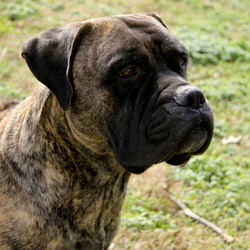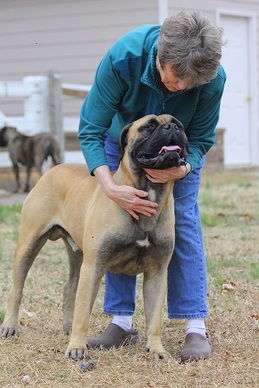History

The Bullmastiff was commonly referred to as the “gamekeeper’s night dog”. The dark brindle coat was preferred because it made the dog nearly invisible in the night. As poaching started to disappear, the dogs were trained to guard estates, and the fawn, or red color became popular.
Eventually, breeders stopped cross-breeding between the Mastiff and Bulldog, and started pure breeding. Perfecting the breed took almost 30 years. The Bullmastiff quickly gained fans all over the world and was preferred over the Mastiff because he was smaller and easier to control.
The Bullmastiff was recognized as a pure breed by the English Kennel Club in 1924 and by the American Kennel Club in 1933.
Temperament
Today the Bullmastiff has become one of America’s most popular family dogs. This is largely due to the bullmastiff’s loyal, loving temperament. He is docile and affectionate and not naturally violent. He will, however, react if he feels his owner is threatened in any way.
The Bullmastiff is extremely powerful and can be an independent thinker. He needs a firm master, who is confident and consistent with training. Bullmastiffs should be thoroughly obedience trained, and socialized with humans and other dogs at an early age. The human must be “leader of the pack”. These dogs are very sensitive to the tone of your voice and need someone to speak with an air of assertiveness, but not harshly.

Standard

The Bullmastiff is powerfully built, and shows great strength. His gait is free and smooth. Movement should indicate power and a sense of purpose. When moving straight, neither front nor hind legs should cross.
The head should be large and square with a fair amount of wrinkle when alert. Forehead should be flat. The muzzle, broad and deep, should be approximate 1/3 the size of the head and dark in color. The ears should be V shaped, level with the occiput and cheeks, and deeper in color than the body. Eyes should be dark and set aside the width of the muzzle with furrow between.
Male Bullmastiffs should be 25 to 27 inches at the shoulder and 110 to 130 pounds. Bitches should be 24 to 26 inches at the shoulder and 100 to 120 pounds. The length from tip of breastbone to rear of thigh should exceed the height from withers to ground only slightly, resulting in a nearly square appearance.
The chest should be wide and deep. Shoulders should be muscular, sloping and powerful. Forelegs should be powerful and straight, well boned and set wide apart, presenting a straight front. The hindquarters should be broad and muscular, with well developed second thighs. Hocks should be moderately bent. The back should be short and straight.
The neck is well arched, moderate length, very muscular, and almost equal to the skull in circumference. The tail should be set high, strong at the root and tapering, and reach to the hocks. It can be carried straight or curved.
The Bullmastiff’s coat is short and dense, giving good weather protection. Accepted colors are red, fawn, and brindle. Except for a small white spot on the chest, white markings are considered a fault.
Links of Interest
http://bullmastiffinfo.org
http://AKC.org
http://dogfoodproject.com
http://manifest.bullmastiffinfo.org/judgesquarry/2002/mullen_March2002
https://www.lonelycreekbullmastiff.com/trimming-dogs-nails
https://www.lonelycreekbullmastiff.com/tappingears-bullmastiff (taco style)
https://bulhaven.wordpress.com/2010/08/05/ear-taping-for-beautiful-ear-set/ (for stubborn ears)
https://yourdogadvisor.com/bullmastiff/

